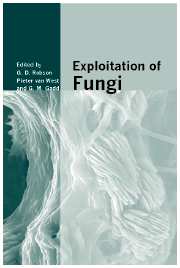Book contents
- Frontmatter
- Contents
- List of contributors
- Preface
- I Comparative and functional fungal genomics
- II Bioactive molecules
- 3 The biosynthesis of polyketides, acyl tetramic acids and pyridones by filamentous fungi
- 4 Fungal metabolites as lead structures for agriculture
- 5 Molecular and genetic analysis of symbiosis expressed secondary metabolite genes from the mutualistic fungal endophytes Neotyphodium lolii and Epichloë festucae
- 6 What can genomics tell us about secondary metabolism in Aspergillus?
- III Protein folding and secretion
- IV Fungal bioremediation
- V Fungal biocontrol of pests
- Index
- References
5 - Molecular and genetic analysis of symbiosis expressed secondary metabolite genes from the mutualistic fungal endophytes Neotyphodium lolii and Epichloë festucae
from II - Bioactive molecules
Published online by Cambridge University Press: 05 October 2013
- Frontmatter
- Contents
- List of contributors
- Preface
- I Comparative and functional fungal genomics
- II Bioactive molecules
- 3 The biosynthesis of polyketides, acyl tetramic acids and pyridones by filamentous fungi
- 4 Fungal metabolites as lead structures for agriculture
- 5 Molecular and genetic analysis of symbiosis expressed secondary metabolite genes from the mutualistic fungal endophytes Neotyphodium lolii and Epichloë festucae
- 6 What can genomics tell us about secondary metabolism in Aspergillus?
- III Protein folding and secretion
- IV Fungal bioremediation
- V Fungal biocontrol of pests
- Index
- References
Summary
Introduction
Epichloë endophytes (Epichloë/Neotyphodium species) are an important group of clavicipitaceous fungi that form symbiotic associations (symbiota) with temperate grasses of the Pooideae subfamily (Scott, 2001a; Schardl, Leuchtmann & Spiering, 2004). These biotrophic fungi systemically colonize the intercellular spaces of leaf primordia, leaf sheaths and culms of vegetative tissue and the inflorescence of reproductive tissues. The asexual Neotyphodium species have no external growth stage and consequently form symptomless associations with their grass host where they are vertically transmitted through the seed following colonization of the developing ovule. Most of the sexual Epichloë species are also transmitted vertically but because of their ability to form external stromata on inflorescence tissue, can also be transmitted horizontally (Leuchtmann & Schardl, 1998; Schardl & Leuchtmann, 1999). The mating system is heterothallic (outcrossing) and in nature is mediated by anthomyiid flies (Botanophila spp.), which transfer spermatia between stromata (Bultman et al., 1995; Bultman et al., 1998). Formation of perithecia and release of ascospores into the environment provides a source of vegetative hyphae that give rise to conidia that subsequently infect new hosts, probably by way of colonization of the stigma and style of the host inflorescence (Chung & Schardl, 1997).
Taxonomy of epichloë endophytes
At least nine different Epichloë species are recognized including E. typhina, a broad host range species (Schardl & Wilkinson, 2000) and E. festucae, a natural symbiont of Festuca spp. (Leuchtmann, Schardl & Siegel, 1994). E. festucae is also capable of forming compatible associations with perennial ryegrass, Lolium perenne (Christensen et al.
- Type
- Chapter
- Information
- Exploitation of Fungi , pp. 59 - 77Publisher: Cambridge University PressPrint publication year: 2007

